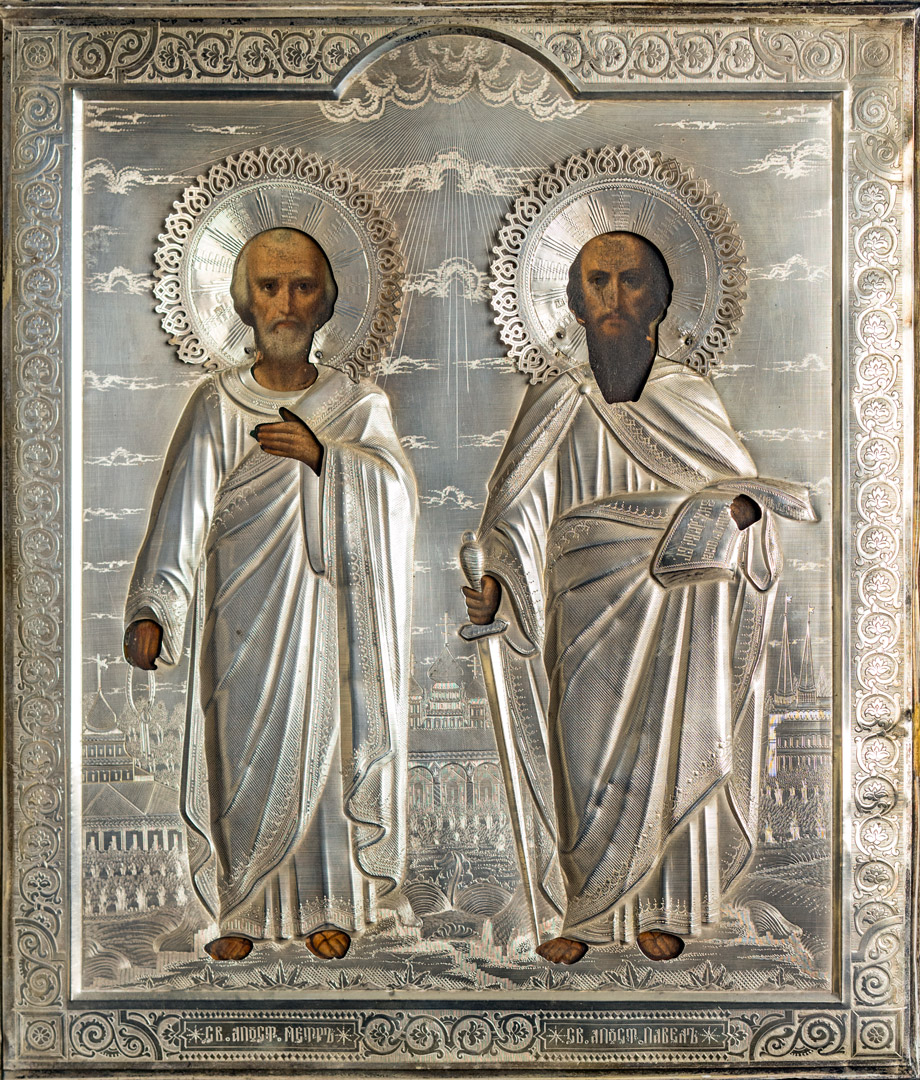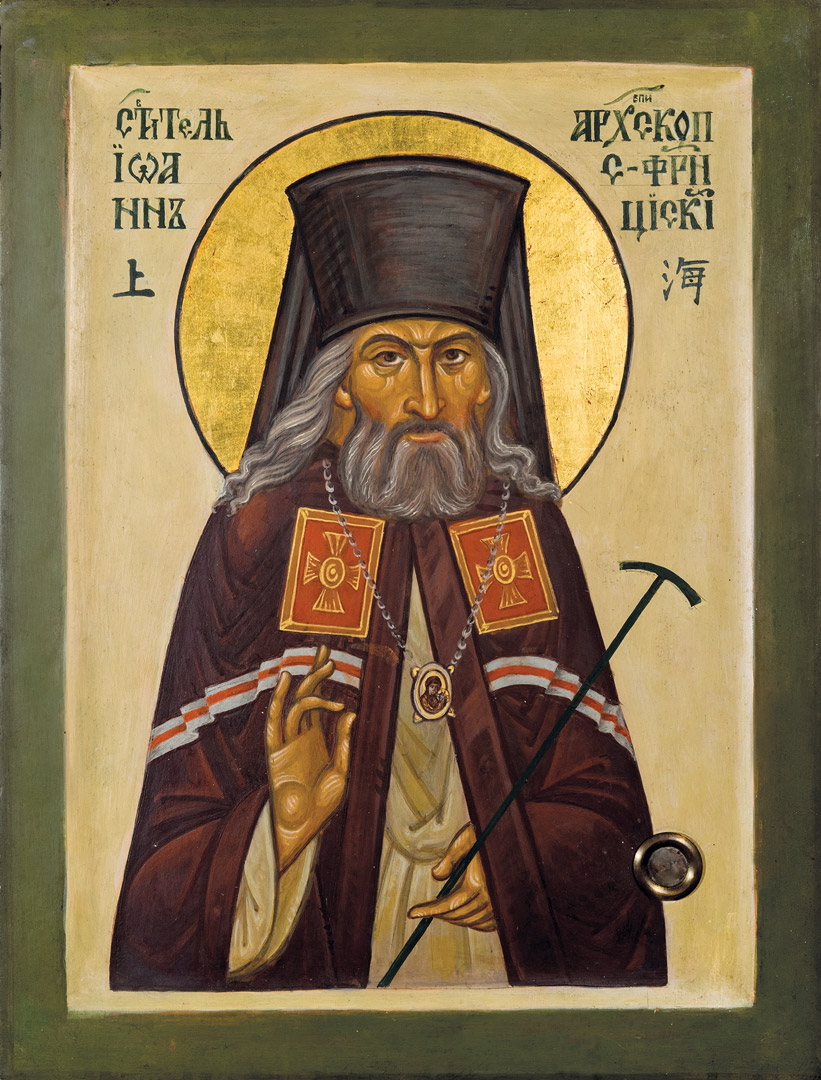The day of the Holy Apostles Peter and Paul is the culminating feasts of the Gospel. Although the last event in the life of Christ which is related in the Gospel as His Ascension into heaven (Mark 16:19 ; Luke 24:51), the preaching of the Apostles is closely bound up with the Gospel. The Gospel tells us of their being chosen, and the Gospel indicates beforehand the end of Apostolic activity. SAINT JOHN OF SHANGHAI AND SAN FRANCISCO

Icon of Apostles Saints Peter and Paul. The icon belongs our parish before its closing in 1972, later it was transferred to Melbourne, for the Church of Sts.Peter and Paul. This Icon was returned to Hong Kong by Fr. Igor Filianovsky after re-opening of our parish.
The day of the Holy Apostles Peter and Paul is the culminating feasts of the Gospel. Although the last event in the life of Christ which is related in the Gospel as His Ascension into heaven (Mark 16:19 ; Luke 24:51), the preaching of the Apostles is closely bound up with the Gospel. The Gospel tells us of their being chosen, and the Gospel indicates beforehand the end of Apostolic activity.
Telling of the appearance of Christ on the sea of Tiberias and the restoration to apostleship of Peter, who by his triple confession corrected his triple denial, the Apostle and Evangelist John the Theologian speaks also of the prediction to the Apostle Peter concerning the end of his struggle. When thou shalt be old, thou shalt stretch forth thy hands, and another shall gird thee, and carry thee whether thou wouldest not. This spoke He, signifying by what death he should glorify God (John 21:18 -19).
It was not pleasing to the Lord then, to reveal the face of each of the other Apostles, although, when sending them to preach, He predicted to them, the persecutions that awaited them (Matt. 10:17 -36). Now, to the question of Peter about John, Christ replied: If I will that he tarry till I come, what is that to thee? Follow thou Me (John 21:22 ).
The mysterious words of Christ about John, and the extraordinary circumstances of the latter’s end, have been the cause for the opinion, which spread in the Church, beginning from the days of the apostles, that John would remain on earth until the Second Coming. Such a view of the end of the earthly life of the Apostle John is set forth in part also in the hymns on the day of his memorial, where mention is made of his special closeness to the earthly Church. Therefore, the Church does not celebrate the day of the repose of the Apostle John the Theologian, which is a1so revered by the Church as a great feast, as is the day of repose of the Apostle Peter, which was definitely predicted by the Lord. It is precisely to the Apostle Peter and to no one else, that the Lord predicted the culmination of his earthly ministry, because it was Peter who first confessed Him, on behalf of all the Apostles, to be Christ, the Son of God; he was the first to receive the promise of power to bind and loose, which was subsequently given to all the Apostles (Matt. 16:16-19; Matt. 18:18); and it was he who renounced Christ and was again restored to apostleship. Indicating to Peter the culmination of his Apostolic preaching when restoring to him the Apostolic calling, the Lord thereby reveals the essence of the Apostolic ministry.
The preaching of the Word of God not only by word of mouth, but also by deprivations, sufferings and death, constituted the following of Christ and the continuation of His work.
The Apostle Peter, as the most zealous of all and one who strove to be before the others in word and deed, by his example aroused the other Apostle Therefore it is primarily him that Christ addresses. He goes in front of the other Apostles, becomes their “leader;” and it is especially to him that the preaching among the Jews was entrusted, while the Apostle of the Gentiles was the one who received precisely this title, being converted later, the no less zealous Paul (Gal. 2:7-9).
These two Apostles were as it were the commanders of the rank of the Apostles, which is expressed (in the service to them) by the word “leaders.”

The particle of the holy relics of the sanctifier is enclosed in the icon of St. John the Wonderworker of Shanghai and San Francisco in the Ss Apostles Peter and Paul Church.
Without having authority over others, they both stood in front of all others by their warm zeal and labors. Their life was the most brilliant and was a personification of the life and labors of all the Apostles. The end of their earthly labors was especially impressive, thanks to the fact that it occurred before the eyes of the whole world. One of them (Peter) was crucified upside down, and the other (Paul) was beheaded, both in Rome , towards which at that time the gaze of all peoples was directed. The news of this quickly dew to all the ends of the universe, all the more in that they were both known personally in many places; their names were everywhere the Savior had been preached.
The Apostle of the Jews and the Apostle of the Gentiles departed to Christ on the same day, as if indicating their equal nearness to God and the oneness of the Church of Christ, in which there it neither Greek nor Jew (Col. 3:11). Therefore, the day on which the earthly labors ended for “the leaders of the Apostles, who labored more than all,” who “separated in body, are together in spirit;” became one of the memorable days for the whole Church.
The Apostle John the Theologian was still a1ive then, being in Ephesus , from where he was exiled to the island of Patmes . Not long before his transition into the other world, he wrote the Gospel, by which he completed the three Gospels written before him, and which he had approved. Having already completed his Gospel, he added to it, the account of the manifestation of Christ on the sea of Tiberias in order that quoting precisely the words of Christ about himself, he might refute the opinion that he had been promised by Christ to remain on earth until the Second Coming.
In this afterward to the Gospel written by him, the Apostle and Evangelist John set forth the prediction of Christ to the Apostle Peter concerning his martyr’s death, and thus he bound the memory of this death with the Gospel.
Just as the last chapter of the Gospel of John is literally the conclusion of the whole Gospel, so also the feast dedicated to the fulfillment of the prophecy set forth there is as it were the conclusion of all the Gospel events kept in remembrance by the Church.
Being an immovable feast, it is nevertheless bound up with the movable feasts, since the preparation for it-the Apostles’ Fast-begins one week after the feast of Pentecost; thus, it depends on the date of the celebration of Pascha.
The feast of the Holy Apostles Peter and Paul indicates the lot of the Holy Apostles here on earth and reveals the glory that followed it.
The earthly lot of the Apostles was to go around the earth preaching of the Heavenly Kingdom, in this emulating Christ by their poverty, endurance of dishonor and sufferings, by their love for the children of the Heavenly Father, their inward torments of childbirth over those who heeded their preaching and their grief over those who paid no heed to their words and finally, by offering themselves as a sacrifice.
However, the culmination of their earthly life is the beginning of their heavenly glory. Their end is for them a dissolving of earthly ties and an ascent to Christ, Whom they loved, in order to remain eternally with Him (Phil. 1:23 ).
The day of their earthly end is the day of their heavenly birth, end the celebration of it is a solemnity of the coming of the future age for those who have followed Christ in this age. The receiving of the crowns of righteousness prepared not only for them, but also for all who love His appearing (II Tim. 4:8). Coming after the feast of the Descent of the Holy Spirit and being in part bound up with it, the feast of the Holy Apostles Peter and Paul culminates the yearly cycle of feasts dedicated to the earthly life of Christ and reveals the essence of His promises.
Just as the Nativity of John the Baptist is the foreword to the Gospel and the beginning of the events described in it, so also the death of the Holy Apostles Peter and Paul is their culmination and the afterward of the Gospel.
The Nativity of St. John the Baptist is the beginning of the preaching of the Gospel of the New Testament on earth; his Beheading is the preaching of it in hell; and the day of the Holy Apostles is the realization of it in heaven.
Kontakion
“The firm and God-proclaiming preachers, the pinnacle of the Apostles, Thou hast received into the enjoyment of Thy good things and into repose; for Thou didst receive their pains and death as above all offerings, O Thou Who alone knowest what is in the heart”
Glory at Lauds
“The feast of the all-honorable Apostles hath come, interceding for the salvation of all of us. Now mystically clapping our hands, let us say: come into our midst invisibly, vouchsafing immaterial gifts for those who praise your feast in hymns”
SOURCE